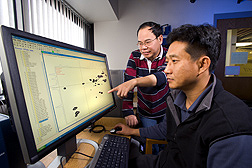This page has been archived and is being provided for reference purposes only. The page is no longer being updated, and therefore, links on the page may be invalid.
Read the magazine story to find out more. |
|
|
Probing Tiny Plant Cells to Unleash Big Bioenergy
By Erin PeabodyApril 3, 2007
Scientists are now getting their closest look yet of plant cell walls, thanks to a new viewing method developed by the Agricultural Research Service (ARS). It's the tough and rigid cell walls that are currently the biggest hurdle for scientists who are trying to convert plant cellulose into ethanol.
Chemist John Ralph and research associate Fachuang Lu, with ARS' U.S. Dairy Forage Research Center in Madison, Wis., created the new cell-viewing technique by combining a sophisticated solvent with the power of nuclear magnetic resonance technology.
Today's ethanol is mostly derived from the starch in corn kernels. However, vast amounts of energy remain locked up in another plant component, called cellulose, which is found in everything from cornstalks to wood chips to manure. That's because plants, over the course of millions of years, have evolved elaborate cell wall structures that guard their sugar-rich cellulose like a fortress.
The new ARS method is allowing researchers to get—for the first time—a detailed structural view of those cell walls. This gives them unparalleled insight when it comes to developing superior biomass crops, such as switchgrass, with easier-to-degrade cell wall structures and traits.
The solvent gently, yet effectively, disentangles cell wall components from one another so that they can be viewed in solution. Then, using nuclear magnetic resonance, the scientists can obtain a detailed chemical "fingerprint" of the major and minor structures in the walls.
Previously, to get a closer look, researchers had to spend weeks laboriously isolating cell wall parts. The new method yields results in a matter of days.
In addition to its potential bioenergy applications, the cell wall fingerprinting technique should also prove helpful in solving problems related to livestock feed inefficiency. That's because the tough and fibrous plant cell walls that are such a headache for biofuel processors are also wasted in undigested animal feed.
To learn more about this research, see the April issue of Agricultural Research.
ARS is the U.S. Department of Agriculture's chief scientific research agency.

